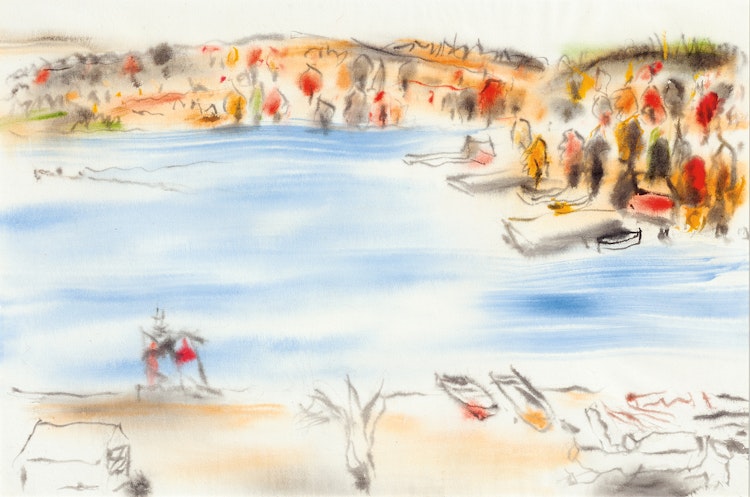Blue Bay, 1952 by David Brown Milne

David Milne
Blue Bay, 1952
watercolour on paper
titled and dated “February 1952” on the reverse; catalogue raisonné no. 503.36
14.5 x 21.5 in ( 36.8 x 54.6 cm ) ( sheet )
Auction Estimate: $15,000.00 - $20,000.00
Price Realized $26,400.00
Sale date: November 27th 2024
Picture Loan Society, Toronto, circa 1953
Douglas Duncan, Toronto
Acquired by the Winnipeg Art Gallery, 1961
"Watercolours by David Milne", Picture Loan Society, Toronto, 28 February-13 March 1953, no. 13
"David Milne (1882-1953)", National Exhibition Centre, Swift Current, Saskatoon, 18 June-18 July 1981
"Historical Canadian Works from the Collection", Winnipeg Art Gallery, 31 May-18 October 1986
"David Milne", Winnipeg Art Gallery; travelling to Art Gallery of Southwestern Manitoba, Brandon; Thunder Bay Art Gallery, 8 January 1998-28 May 2000
David P. Silcox, "Painting Place: The Life and Work of David B. Milne", Toronto, 1996, reproduced page 367
"The Winnipeg Art Gallery, 1912-1962: An Introduction to the History, the Activities and Collection", Winnipeg, 1962, page 28
"David Milne (1882-1953)", Swift Current, Saskatoon, 1981, unpaginated, reproduced
Amber Nasrulla, 'Baptiste Lake: Big Rocks, Big Fish, A Big-Name Artist-and Bancroft Right Next Door', "Cottage Life", Vol 10.1, March 1997, reproduced page 85
David Milne Jr. and David P. Silcox, "David B. Milne: Catalogue Raisonné of the Paintings, Volume 2: 1929-1953", Toronto, 1998, listed and reproduced page 974, no. 503.36
A keen observer of nature, Milne had an extraordinary ability to capture details in his surroundings with a radical economy of means. Art historian David Silcox noted; “Unlike other painters of the Canadian landscape, Milne was attuned to the subtler qualities of temperature, humidity, wind and light… Milne seems to have taken his measure of the landscape by the feeling of it on his skin, by the height, formation, colour and character of clouds, and by the effect of sunlight on the whole vista.”
“Blue Bay” depicts the lake from a high vantage point, with cabins, docks and boats dotting the shores. In his late period, Milne often dampened the paper before applying watercolour paints, creating a delicate, soft-focus effect. Rapid, energetic lines help to define the scene.
With direct and deliberate wide swaths of blue, Milne efficiently depicts sunlight on open water. Rather than complete his watercolours en plein air, Milne often sketched quickly from observation in pencil, working up his impressions in paints in the following days or even months later. Noted in the artist’s diary, “Blue Bay” was painted in February but wonderfully celebrates the brilliant hues of autumn.
Share this item with your friends
David Brown Milne
(1882 - 1953) Canadian Group of Painters
Milne was born near Paisley, Ontario. A childhood interest in art, which revived while he was teaching, led him to take a correspondence course and eventually he travelled to New York City to continue his studies. This was somewhat of an exception in the early twentieth-century Canadian art scene as the majority of artists went to Europe to study. While in New York City, Milne worked as a commercial illustrator for several years before deciding to give up this work and devote his time to painting. Shortly after making this decision he moved to Boston Corners in New York.
Throughout his life Milne sought the peace and solitude of a rural life. In his paintings, Milne explored different viewpoints. He greatly admired the work of Tom Thomson but had little interest in the nationalistic approach of the Group of Seven. His themes range from landscapes to views of towns and cities, still lifes and imaginary subjects. His experiments with different media and changing viewpoints show his interest in the process of painting itself. In 1929, Milne returned to settle permanently in Canada, stopping for brief periods in Temagami, Weston, and Palgrave. He built a secluded cabin at Six Mile Lake, north of Orillia, and spent the next six years painting, for the most part, alone. Milne was interested in 'pure' painting, in "adventures in shape, colour, texture and space" as he called his watercolours of the 1930s and 1940s. The change from the less vibrant drybrush "adventures" to the fantasy watercolours is often attributed to the birth of his only child, David Jr., born to Milne's second wife when Milne was sixty. His young son encouraged him to adopt a new, vibrant and often whimsical approach to his art. Milne spent the rest of his life in Uxbridge, north of Toronto, exploring the Haliburton and Bancroft areas as well as the city of Toronto.

